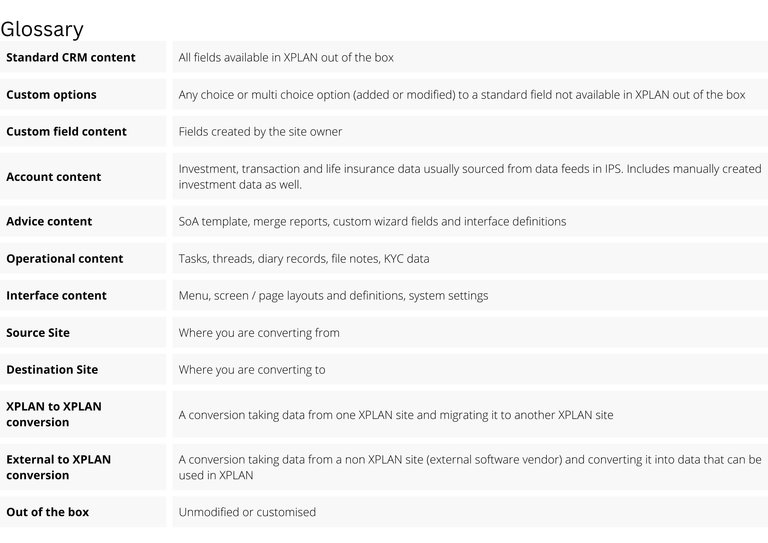If you have been in the advice profession for 7 years or more, you have probably experienced one or more migrations (conversions) of your client data.
Client information is without doubt one of the most valuable assets in your business. Advice firms like yours spend big money and enormous amounts of time keeping it up to date, compliant and relevant. Client data of great quality and currency, reflects and impacts the value of your business and the perceived professionalism of your staff.
From time to time, it becomes important to move your client data between software tools. Maybe you have purchased new software. Maybe you have simply grown out of the site you are sharing with your other ‘advice flatmates’ and feel and want more control over your advice direction and vision.
As an XPLAN customisation firm we work a lot with practices who are either parting ways with their licensee or simply growing quickly and need more flexibility over content and process.
Whether you are switching to XPLAN from an external system or simply moving to your own XPLAN site, when it’s time to pack up and move out there are some important things to consider. Failure to keep a handle on your client data and ‘starting from scratch’ is not a good place to be and can actually damage your business.
Equally important is the relationship you have with the business that owns the site you currently use. Depending on your circumstances, a healthy relationship with your outgoing licensee or site owner will go a long way to ensuring your valuable info can be smoothly transferred out ready for your next adventure.
It’s all about the mapping
Migrating data between systems starts and ends with mapping fields between sites. Last Name in system 1 equals Surname in system 2. (you get the idea) Sometimes it’s obvious ….and in others, not so obvious. Most vendors have a good grasp of the data structure of their competitors and have off the shelf migration tools that can match 90% of the standard data fields.
But depending on when their conversion was created, the matching might not cover all the data points. A conversion created two years ago may not convert data on enhancements created post that date.
Client data in all advice tools tends to span the following categories.
- Standard CRM content
- Custom options
- Custom field content
- Account content
- Advice content
- Operational content
- Interface content


Standard CRM Content
XPLAN to XPLAN conversion
XPLAN conversions are always executed by IRESS and in base form, only cover Standard CRM content.
Tip 1: Consider if the Source Site utilises fields not currently visible on your new Destination Site. Whilst your data may migrate successfully, it may not be visible on the Source Site. So make sure you can see all migrating fields on your new Destination Site.
Tip 2: If a standard field on your source site has been modified with a custom option, the Destination Site must be setup to support this change. For example. If the Source Site contains the title option “Master” and the destination site does not, the option “Master” must be either added to the destination site prior to conversion or mapped to an alternative option prior to the conversion. In essence, both sites must mirror the same options. If not, the value may not convert and a whole bunch of clients may have no title at all, or worse still, a random title that you didn’t choose.
External to XPLAN conversion
Tip 3: Comments are king. Conversions often place fields that cannot be mapped into comment fields. When reviewing your conversion results
- Make sure you have the required comment fields exposed on your destination XPLAN site so you can see if any content has been placed into these areas.
- Comment fields have limited integration capability with workflow tasks. So, if some content has been placed into comments that is used in your practice’s processes, consider mapping this field to a custom field all on its own. Speak with PlanFocus and your IRESS account executive about the right approach for you.
Custom content
XPLAN to XPLAN
If you wish to include custom fields in your migration you must make sure to mention it to your IRESS account manager. Custom field migrations may not be automatically included in the standard service. If you come from a large licensee site, you are almost certain to have a heavily customised dataset, so be aware. If you want this data, you must request it.
Tip 4: Document and identify each custom field and provide to IRESS. This conversion usually runs after the standard conversion is applied.
Tip 5: The Source XPLAN Site owners may be able to provide documentation or extracts to help you with identifying custom fields. Some licensees see this as their Intellectual Property, so ask nicely. Unless your right to the data is written into your licensee agreement, there may be no obligation to provide you with anything data related.
External to XPLAN
For an external vendor conversion to XPLAN, every field is arguably a custom field. IRESS spend significant time, mapping all the vendors fields to XPLAN fields.
Account content
Account content includes client account and investment information either entered by you or downloaded in a data feed. The EPI standard devised by COIN and IRESS has gone a long way to remove the pain for platforms, insurers and vendors in sourcing data for advisers. At this point in time, all vendors utilise many of the EPI feed standards.
Tip 6: Don’t migrate account data that you can re-access post migration. Only migrate account content that you cannot refresh once on your new site. There are exceptions of course. These are:
- Accounts where you have modified the downloaded transaction history
- Accounts with feeds that do not offer full inception refreshes (eg. Macq CMA)
- Account content created manually (keyed)
Tip 7: If you choose to migrate 100% of your account content, be aware that this also includes closed accounts. Be prepared for a longer conversion timeframe as this decision could delay the change-over to your new system as the import system processes all those transactions. If in doubt see Tip 6!
Tip 8: For migrations coinciding with a change of licensee, changing adviser codes impacts your data feeds. The timing of this is crucial. An adviser code change immediately stops a feed against the old code. Delays in getting your new adviser code assigned impacts ‘when’ your new feed will start. Platforms can take a long (long) time to change your adviser codes. Keep each platform, life company, supplier involved in the conversion timeframe to ensure that you get the codes changed over at the right time. In our experience, it can take up to 4 weeks between adviser code changes before data feeds are all operational again. The more diverse your platform strategy, the more time this can take
Tip 9: If you think you might be impacted by Tip 8, consider running any periodic client reporting before you migrate; even if this means running them earlier than normal.
Advice Content
XPLAN to XPLAN
Advice content can normally be transferred. Assuming you own the rights to the advice content of course.
Tip 10: Advice content is heavily driven by custom fields (see tips 4 + 5). Advice content often relies on screen layouts (wizards) and these need to be migrated. XPLAN supports the ability to export page and field definitions. These need to be exported from the source site and imported into the destination site. This process will ensure that not only the wizards migrate but also the fields contained in it. Again speak with PlanFocus or your IRESS account manager to arrange this to be done.
Tip 11: NOTE: If you do not have any ownership of this advice content data you could be breaching the site owner’s intellectual property by migrating it. Check your agreements with your licensee or site owner.
External to XPLAN
Tip 12: If you are migrating from an external vendor to XPLAN, the advice content will need to be re-written into a format that XPLAN supports. There is no conversion for this data.
Luckily this is what we do….contact PlanFocus or IRESS for all your advice content production needs.
Operational Content
XPLAN to XPLAN
Tasks, threads and diary events can all be migrated in a standard migration.
Tip 13: When migrating tasks consider the timeframe between extraction and conversion and task due dates. Consider getting all outstanding tasks completed by the extraction date. This means that all tasks will migrate as completed leaving a clean slate to start on your new site.
Tip 14: If you have a long term history of tasks, consider only migrating tasks that were created less than 12 months ago. Do you really need all that historical task information?
Tip 15: File notes and KYC data. You need and want them all. Consider if you have been using custom file note types and subtypes, these will need to be mapped and mirrored on your destination site.
Tip 16: Diary colour coding and categories. Consider taking an extract of the system settings for diary colours and categories. Mirror these in your destination site so Client Review Meeting doesn’t migrate as Client Exit Meeting or something equally frightening.
Interface Content
XPLAN to XPLAN
XPLAN’s screen layout and menu can be customised and most sites tend to have their own bespoke look and feel. This means that navigating your new XPLAN site (out of the box) can look very different to the site you have come from. This can also make testing your migration difficult if you don’t know where to go to locate the data.
Tip 17: Take screenshots of screens for 10 clients. This will enable you to not only test the quality of the migration but also give you a good view of the layout of the source site.
Tip 18: Depending on your relationship with the owners of the source site, each XPLAN page can be exported and then imported into your destination site. In our experience, this is rarely made available to practices leaving their parent licensee site. So consider take screenshots of all pages on your source site that you like the layout of.
Tip 19: Take screen shots of your source site preference screen pages. These contain all the base settings for each user. These can then be re-created in your new site.
Conclusion
Migrating and or converting your client data is a sign of growth and the need for more control over your advice delivery. You should see it also as an opportunity to improve processes, improve data integrity and client engagement. By considering these tips on converting data you will be in a better position to quickly get back to servicing and helping clients achieve their goals.
Remember, poor data is bad for business. Achieving and maintaining high quality data requires organisation and commitment.
PlanFocus are the leaders in high-end XPLAN customisation. We provide tailored solutions for licensees and practices with an advice vision that is hand crafted to suit your business. Our consultants work with you to ensure a superior outcome is always within reach with you in control at all times.
Tip 20: If you would like help cleaning up your XPLAN or want to learn more about our migration support services, please visit Planfocus and get in touch.
Further Reading: Is data quality affecting your business?

